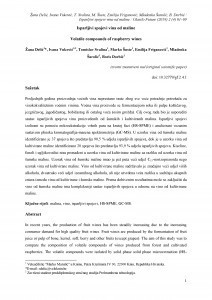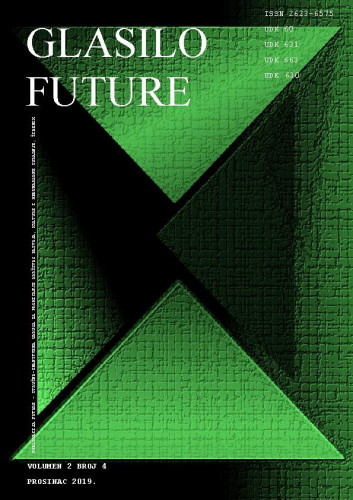Posljednjih godina proizvodnja voćnih vina neprestano raste zbog sve veće potražnje potrošača za visokokvalitetnim voćnim vinima. Voćna vina proizvode se fermentacijom soka ili pulpe koštičavog, jezgričavog, jagodičastog, bobičastog ili ostalog voća (osim grožđa). Cilj ovog rada bio je usporediti sastav isparljivih spojeva vina proizvedenih od šumskih i kultiviranih malina. Isparljivi spojevi izolirani su pomoću mikroekstrakcije vršnih para na krutoj fazi (HS-SPME) i analizirani vezanim sustavom plinska kromatografija-masena spektrometrija (GC-MS). U uzorku vina od šumske maline identificirano je 37 spojeva što predstavlja 90,5 % udjela isparljivih spojeva, dok je u uzorku vina od kultivirane maline identificirano 20 spojeva što predstavlja 93,9 % udjela isparljivih spojeva. Kiseline, fenoli i ugljikovodici nisu pronađeni u uzorku vina od kultivirane maline za razliku od uzorka vina od šumske maline. Uzorak vina od šumske maline imao je pet puta veći udjel C13-norizoprenoida nego uzorak vina od kultivirane maline. Vino od kultivirane maline sadržavalo je značajno veći udjel viših alkohola, dvostruko veći udjel izoamilnog alkohola, ali nije utvrđena veća razlika u sadržaju ukupnih estera između vina od kultivirane i šumske maline. Prema dobivenim rezultatima može se zaključiti da vino od šumske maline ima kompleksniji sastav isparljivih spojeva u odnosu na vino od kultivirane maline.; In recent years, the production of fruit wines has been steadily increasing due to the increasing consumer demand for high quality fruit wines. Fruit wines are produced by the fermentation of fruit juice or pulp of bone, kernel, soft, berry and other fruits (except grapes). The aim of this study was to compare the composition of volatile compounds of wines produced from forest and cultivated raspberries. The volatile compounds were isolated by solid phase solid phase microextraction (HS-SPME) and analyzed by gas chromatography coupled with mass spectrometry (GC-MS). In the forest raspberry wine sample 37 compounds were identified, representing 90. 5 % of the volatile compounds content, while in the cultivated raspberry wine sample 20 compounds were identified, representing 93. 9 % of the volatile compounds content. Acids, phenols and hydrocarbons were not found in the sample of cultivated raspberry wine as opposed to the sample of forest raspberry wine. C13-norisoprenoids were present in five times the proportion in the forest raspberry wine sample than in the cultivated raspberry wine sample. Cultivated raspberry wine contained a significantly higher content of higher alcohols and twice the content of isoamyl alcohol, but no major difference in the content of total esters was found between wines from cultivated and forest raspberry. According to the results obtained, it can be concluded that forest raspberry wine has a more complex composition of volatile compounds compared to cultivated raspberry wine.
Sažetak

 Glasilo Future : stručno-znanstveni časopis 2,4(2019) / glavni i odgovorni urednik Boris Dorbić.
Glasilo Future : stručno-znanstveni časopis 2,4(2019) / glavni i odgovorni urednik Boris Dorbić.